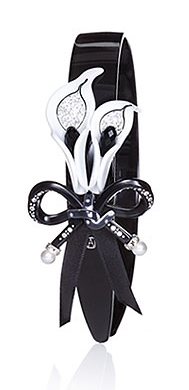Lalique’s cattleya orchid is made of ivory, gold, enamel, horn, and diamonds, c. 1903-1904, and resides in the Cleveland Museum of Art. However, the view we usually see of it does not reveal its secret: what René was really thinking when he made it. Last night, I found the truth. Blessed be the genius who loves a woman’s body with his flowers.
Les Peignes Art Nouveau
Par le Musée Creative
L’Art nouveau est un mouvement artistique qui naît en Europe à la fin du XIXe siècle et rencontre un succès immédiat. Il se développe même internationalement et prend des noms différents selon les pays qui l’adoptent: Tiffany aux Etats-Unis, Skonvirke au Danemark, Stile Liberty en Italie, etc…Le terme français « Art nouveau » s’est imposé en France et même en Grande-Bretagne.
Ce style s’appuie essentiellement sur l’esthétique des lignes courbes. Ses thèmes de prédilection sont la nature, la femme et la mythologie. De grands artistes comme René Lalique ou Lucien Gaillard ont créé des ornements de coiffures somptueux, très recherchés aujourd’hui. Plus modestement, de nombreux artisans français se sont inspirés de leurs créations et ont façonné des peignes ou des épingles au design très poétique. L’ornement de coiffure Art Nouveau français est le plus souvent en corne claire que l’on peint pour imiter la nature. Il est parfois embelli de pierres, de perles ou de métal précieux comme l’or ou l’argent.
Creative Museum possède une collection exceptionnelle d’ornements de coiffure Art Nouveau. Pour ceux qui veulent en savoir plus, ne manquez pas en septembre prochain, notre prochaine exposition qui sera entièrement consacrée à ce style. Voici quelques pièces à admirer en avant-première.
(You may read the English translation in the first comment.)
Copyright: www.creative-museum.com
Chinese Comb of Gods
This impressive ivory comb features the eight Chinese Gods from the Dao Temple, home of Taoism. The artist portrayed the immortals crossing the sea. Respectively, they represent incarnations of the Chinese people: male, female, old, young, rich, noble, poor, and humble. Zhang Guolao’s drum can augur life. Lu Dongbin’s sword can subdue evil. Han Xingzi’s flute can cause growth. He Xiangu’s Water Lily can cultivate people through meditation. Tie Guaili’s gourd can help the needy and relieve the distressed. Zhong Liquan’s fan can bring the dead back to life. Cao Guojiu’s jade board can purify the environment. Lan Caihe’s basket of flowers can communicate with gods. All of this wisdom was carved into a comb made for export to the Victorian market, c. 1890.
The Innovation of Josephine
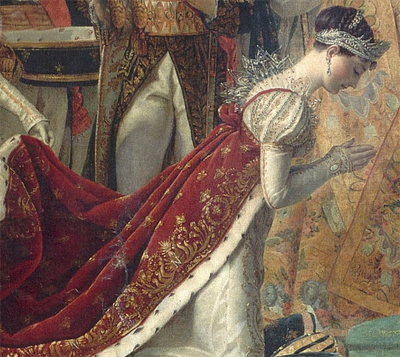
As Napoleon’s passionate love, Josephine, kneels before him at his coronation, she introduced two enduring jewelry designs: a woman’s laurel-leaf tiara and a comb with round stones on a stem, forever to be known as the Peigne Josephine. She is wearing the comb in the middle of her head to secure a braid. Napoleon’s laurel-leaf crown imitated Ceasar’s. But Jacques Louis David’s landmark 1804 painting allows us to contemplate Josephine as one of the great jewelry innovators of her time.
Some Early Edo Masterpieces
The Tokugawa Shogunate ruled Japan from 1637 to 1867. They closed the country to foreigners, and Japanese decorative arts remained a mystery to the Western World. Although porcelain continued to be exported, Japan did not come out of seclusion until the Meiji Era began in 1868. In the Paris Exposition of 1872, Western artists first saw early Edo combs. Japonisme began. Here are three early Edo masterpieces Paris artists might have seen. The style and shape of these combs gives the artist a large canvas, on which they paint one idea.
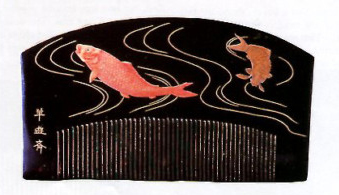
I believe this is a painted tortoiseshell comb of a tree branch extending over a lake. Insects are flying about. Where the artist reveals the tortoiseshell adds shadows to the insects. The fish painted on the tines represent the fish underneath the lake. Look at the shading blend from top to bottom. This is a masterpiece.
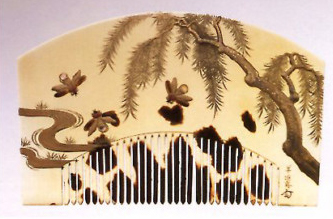
Edo artists painted on glass, too.
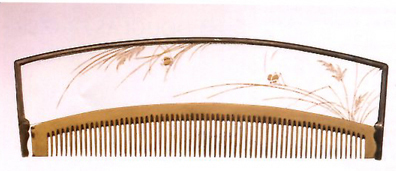
Diamond and Aquamarine Tiara
Topped by a pear-shaped aquamarine, this tiara was owned by Princess Olga Valerianovna Paley. She was born Olga Karnovitsch on Dec. 2, 1865, married Erich Gerhard von Pistohlkors in 1884, had an affair with Grand Duke Paul Alexandrovich of Russia, married him without the Tsar’s approval, but then got his blessing and became a Princess. After her husband and son were killed by the Bolsheviks in 1920, she fled to Finland with her two daughters. She died in Paris on November 2, 1929. Being a woman, no matter what happened to her, she kept the tiara. It is signed Cartier Paris, Londres, New York, was made c. 1912, and sold for $76,000 at Sotheby’s on May 12, 2009.
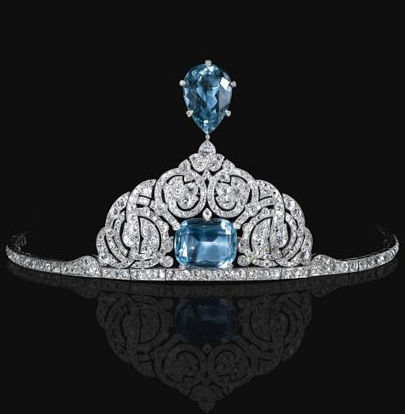
The Bargain
Amidst the cacophony of egos, E-bay is a war game. To sell collectibles, you either have to organize in real life to limit supply, as in the paperweight market; throw a piece of junk on ebay with the goal of attracting a private buyer, as in the Tiffany Studios market; but sometimes the collector wins the war because the seller is blindingly stupid.
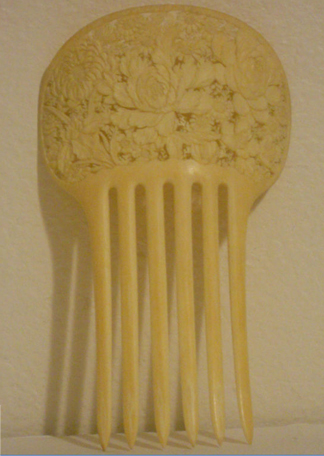
PCMalady listed this comb as plastic. It wasn’t plastic. It was a Chinese ivory comb made for export to the Victorian market, c. 1890.
I couldn’t believe it. For four days I had a kill snipe bid on this. I knew the people who noticed it would behave like stealth tigers looking to take advantage of the seller’s ignorance. I also knew no one who noticed would bid to draw attention to the comb, thereby jacking up the price. I deleted my snipe bid because I thought “What are you doing? You can’t buy combs now.” I watched.
A comb I’d value at around $300 because there was a slight discoloration to the ivory in the back, invisible to the front, went for $39.99.
Even if the seller did not know the detailed floral decoration was one of the most popular patterns in Chinese ivory export combs, she should have seen the individuality of the discoloration on the back and known the comb was not plastic.
There were only two bidders, feedback scores of 2078 and 3309, respectively. That tells you a lot about their knowledge. The comb was won by the Creative Museum. I am happy about this. It was a brilliant buy.
At the moment, sellers on Ruby Lane are trying to sell their combs for retail prices on E-bay. The listings will not succeed because the main product of E-bay is the war game of egos.
Coming soon: The dazzle of the U.S.
The Creative Museum is happy to present its new exhibition on American celluloid rhinestones combs.
1st February / 30th August 2011
To be seen on http://www.creative-museum.com/en
Don’t miss!
 In the U.S. at the beginning of the twentieth century, high society parties were particularly dazzling affairs. Classy women used to enhance their hairstyles with brightly-coloured combs set with sparkling rhinestones.
In the U.S. at the beginning of the twentieth century, high society parties were particularly dazzling affairs. Classy women used to enhance their hairstyles with brightly-coloured combs set with sparkling rhinestones.
Dragons, Griffons et Autres Bêtes Fantastiques
Tout le monde a rencontré, soit dans des films, des romans, des mangas ou des jeux vidéos ces créatures fantastiques qui combinent les attributs de plusieurs animaux comme le centaure, le sphinx ou la chimère… La mythologie antique est riche de ces figures imaginaires, et on en trouve dans toutes les cultures du monde.
C’est le dragon qui est la créature la plus représentée. Il se décline sous de nombreuses variations et peut même avoir des ailes comme le griffon.
Outre son pouvoir symbolique, ses qualités décoratives sont indéniables et les ornements de la coiffure en offrent des exemples souvent remarquables.
creative-museum.com vous en présente ici une petite sélection.
Commençons par la Chine où le dragon incarne le pouvoir et la force. Il était autrefois l’emblème de l’empereur.
Peut-être préférerez-vous un zilant russe, autre bête fantastique dérivée du dragon ?
Ou encore deux dragons-serpents s’enroulant autour d’une guirlande de roses sur un peigne français de style Empire…
Deux étonnants dragons-chiens de la mythologie indonésienne de Bornéo.
Enfin deux griffons sur un peigne de toilette en écaille de tortue.
The Breathtaking Alexandre de Paris
Some Selections from the Winter 2011 collection. You can only get them in stores, and they sell for thousands now. I would pick all of these and have them sent as a matter of principle.
Butterfly Tiara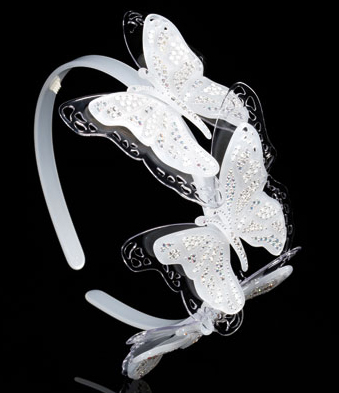
Rare Mother of Pearl flower barrettes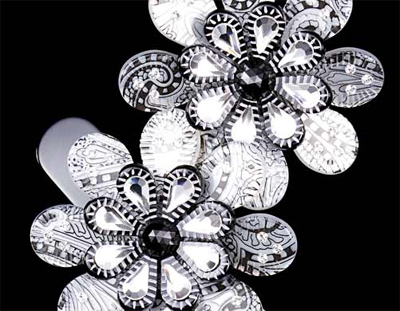
Art Deco Butterflies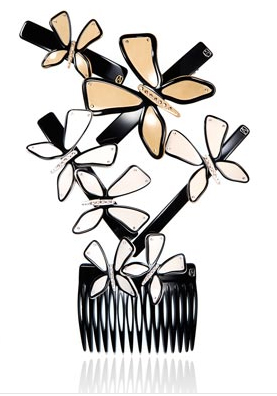
Camelias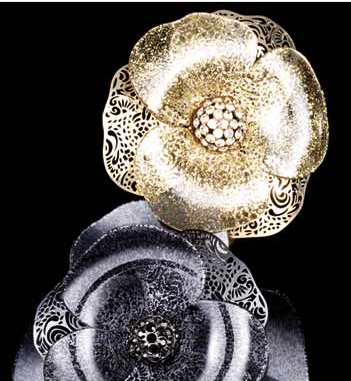
Art Deco Lily Tiara